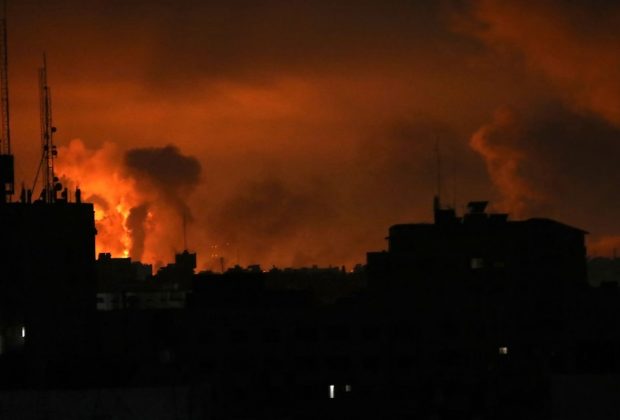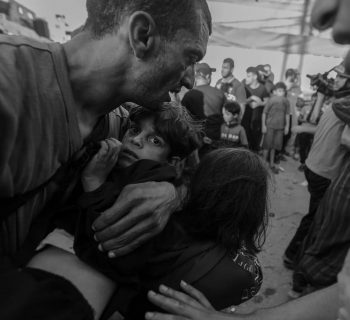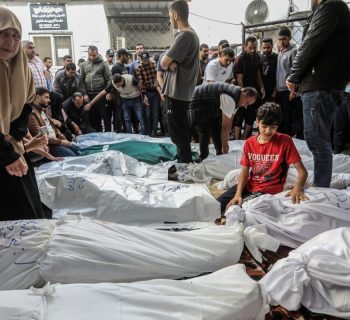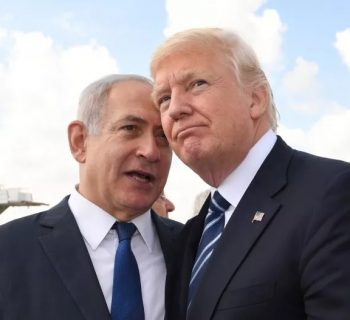By Shadi Hamid | The Washington Post | NOV. 8, 2023 | Photo by Abed Khaled
The destruction in Gaza has reached staggering levels. More than 4,000 children have died — equivalent to 600,000 children as a share of the U.S. population. It is not sufficient to say war is tragic, although it is. It is true that Israel doesn’t deliberately aim to kill civilians. But for the Palestinians who must mourn their dead, are they supposed to find solace in the notion that Israel didn’t intentionally target their loved ones, when the outcome is the same?
What might a plausible cease-fire look like in practice? The specifics matter. Any proposal must take seriously Israel’s legitimate security needs. First, Hamas must agree to release hostages and commit to halting rocket fire into Israel. In exchange, Israel would agree to stop its bombardment of Gaza as well as any ground incursions into Gazan territory.
Once this first step is taken, a cease-fire would allow for further negotiations on what comes next. These talks should be led by the United States, with the active support of governments in communication with Hamas — namely Qatar and Turkey. These countries should demand that Hamas offload its governing responsibilities in Gaza to the Palestinian Authority.
While it will be challenging to iron out the specifics of such an arrangement, some rough outlines can be sketched. Just as it is unrealistic to ask Israel to accept an unconditional cease-fire, so, too, is the notion that Hamas can be “eradicated.” Unlike al-Qaeda or the Islamic State, both of which often relied on foreign fighters, Hamas members and their families are Palestinian. Truly eliminating the organization — one with hundreds of thousands of supporters and sympathizers — would require mass killing on an unprecedented scale.
But if Hamas members won’t disappear, what happens to them? Any intra-Palestinian negotiations should include a path for low- and mid-level Hamas cadres, as well as members of the group’s political leadership, to be incorporated within any future governing structure. Without one, the Palestinian Authority will continue to suffer from a major legitimacy deficit. Under any such “reconciliation” agreement between Palestinian factions, armed groups would need to demobilize and integrate their military forces within those of the Palestinian Authority. Elections would need to be held within a reasonable time and, in order to participate, members of Hamas and other militants would need to commit to pursuing any political aims through the ballot box.
All of this might sound like a fantasy. But ambitious and imaginative proposals often begin as fantasies. One must start somewhere, after all.
And there is precedent. In previous Egyptian-brokered Palestinian reconciliation agreements, including the 2014 Shati Agreement and the 2017 Fatah-Hamas Agreement, Hamas agreed to subject itself to the authority of a consensus government that would abide by previous agreements with Israel. Of course, after the horrific attacks against Israeli civilians on Oct. 7, there is no reason to take Hamas at its word. Compliance would need to be closely monitored. But a cease-fire is not a peace deal. If elements of Hamas were to renege on an intra-Palestinian agreement and resume rocket fire or armed maneuvers inside of Israel, then the Israel Defense Forces would have the right to resume military action against targets in Gaza.
This is not a time for repeating old mantras or hoping that Israel, through the goodness of its own heart, might agree to a cease-fire because it is the right thing to do for Palestinians. Israel, like any state, will prioritize its own citizens. In other words, we might wish it were otherwise, but Israel is not uniquely malevolent for caring less about Palestinians.
At the same time, Palestinians would need reason to believe that new governance arrangements in Gaza would not be the end of the story. A return to the status quo ante, including a continuation of an Israeli blockade, would create the conditions for future radicalization and fatally undermine the legitimacy of any authority in Gaza. Palestinians need to be shown — by the Biden administration and by Israel — that an independent state incorporating Gaza, the West Bank and East Jerusalem is possible, not just in word but in deed.
Future U.S. military aid to Israel must be made contingent on it committing in good faith to this path. The Israeli government could not merely say that it accepts Palestine’s right to exist (although that would be nice). It would need to take concrete and tangible measures toward the establishment of a Palestinian state, including by entering into direct and unconditional negotiations with the Palestinian Authority.
The United States must use its leverage to bring Israel to the table. The alternative is a return to prewar conditions in Gaza and the West Bank that is dangerous for Palestinians and Israelis alike. In such an environment of hopelessness, Palestinians would likely lose faith and again gravitate toward supporting armed insurrection.
To be sure, any prospect of peace between Israel and the Palestinians remains far off. But the lack of a clear vision for exactly how to achieve it shouldn’t stand in the way of doing what can be done today. Now and not later, a cease-fire is necessary. Fortunately, it is also possible.







